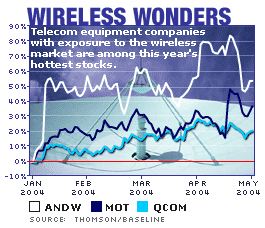
NEW YORK (CNN/Money) -
Have you ever heard of a company called Andrew Corp.? Probably not. So why should you care about it?
Well, do you own one of the scores of S&P 500 index funds out there? If so, you should thank your lucky stars that Andrew (ANDW: Research, Estimates) is one of the 500 stocks in the index. Shares are up an astonishing 54 percent year-to-date, making it the third-best performing stock in the S&P 500 this year.
So what's so dandy about Andy? The company manufactures wireless antennas, amplifiers, filters and coaxial cables. That may sound like a snooze-fest. But you know what? Telecom equipment stocks are sexy again.
"Telecom infrastructure got beat up so much after 2000 and now going forward, there's some stabilization and near-term demand. It shows you there are cycles," said Ren Zamora, an analyst with Loop Capital Markets.
In fact, Motorola (MOT: Research, Estimates), Qualcomm (QCOM: Research, Estimates), Lucent Technologies (LU: Research, Estimates), Corning (GLW: Research, Estimates), Avaya (AV: Research, Estimates) and Tellabs (TLAB: Research, Estimates) are also sporting double digit percentage gains this year. By way of comparison, the S&P 500 is flat and the Nasdaq is down 2 percent in 2004.
Cutting the cord
After a long drought in the telecom business, cell phone companies such as Verizon Wireless and Cingular, which is buying AT&T Wireless, are finally starting to spend again in order to improve their networks and roll out new services. And consumers are eating up high end cell phones with built-in cameras and color screens.

"Wireless is on fire. I don't see what slows wireless down," says Michael Mahoney, managing partner with hedge fund firm EGM Capital, who said he's playing the wireless trend primarily by investing in communications chips companies such as Vitesse Semiconductor (VTSS: Research, Estimates) and Triquint Semiconductor (TQNT: Research, Estimates).
Now even though it's tempting to look at the gains in many of these stocks and declare that another bubble is in the process of inflating, many telecom equipment companies still have strong growth prospects and attractive valuations to boot.
Take a look at Andrew for example. Earnings for this fiscal year, which ends in September, are expected to more than double from a year ago. And in its next fiscal year, analysts expect Andrew's earnings to increase by 63 percent. But despite this year's big run, the stock still trades for just 22 times next year's estimates.
Avaya, which lost money in its last fiscal year, is trading at 20 times earnings estimates for fiscal 2005. Earnings are expected to increase by 83 percent next year.
And even Lucent, which I've been skeptical of in the past, seems to have finally gotten back on track as well. It reported its third consecutive quarterly profit last month and has a P/E of 22, based on next year's estimates. That's reasonable, considering that analysts are predicting a profit increase of 50 percent next year.
Eric Buck, an analyst with Janco Partners, said that most telecom equipment companies have done a solid job of cutting costs during the downturn and this is finally bearing fruit. So even though revenue growth is unlikely return to the lofty levels seen during the last bubble, Buck said that companies like Tellabs still have a chance to post sizable gain in profits.
"Earnings improvement over the next 12 to 24 months will be driven by operating expense control," he said.
Along those lines, Swedish networking firm Ericsson (ERICY: Research, Estimates), is expected to be back in the black in 2004 after losing money last year. The stock is trading at 23 times earnings 2004 estimates and Zamora said he likes the company's global exposure to the wireless market.
And Motorola, trading at 25 times estimates for 2004, is another favorite of Zamora. The company reported first quarter earnings and sales last month that blew away analysts' expectations, a sign that new CEO Ed Zander may be turning things around more quickly than investors had thought possible, Zamora said.
Of course, it's understandable why investors may be reluctant to embrace some of these companies again since they were burned badly by many telecom equipment stocks during the last bear market.
But that doesn't mean that the stocks should be avoided forever. Investors just need to pay close attention to valuations and not overpay for these stocks. The worst appears to be finally over and with demand for wireless services booming, there's no reason why this couldn't be the start of a new, albeit more modest, cyclical upswing for telecom spending.
"I don't think the cycle is about to end. Telecoms are just beginning to dig out of the hole," said Mahoney.
Janco's Buck owns shares of Lucent but his firm does not have any banking relationships with any of the companies mentioned. Loop Capital's Zamora does not own shares of any companies mentioned and his firm has no investment banking ties to them.
Sign up to receive the Tech Investor column by e-mail.
Plus, see more tech commentary and get the latest tech news.

|

